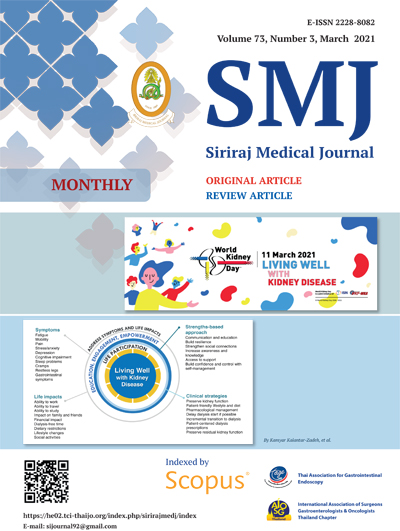Diagnosis and Initial Management of Agitated Patients in a General Hospital
DOI:
https://doi.org/10.33192/Smj.2021.23Keywords:
agitation, delirium, alcohol withdrawal, diagnostic concordance, restraint, consultation-liaison psychiatry, diagnosis, management, benzodiazepine, antipsychoticsAbstract
Objective: To examine the characteristics, diagnosis and management of agitated inpatients before psychiatric consultation in a general hospital.
Methods: A retrospective chart review of inpatients aged 18 years or older that were referred for psychiatric consultation due to agitation in a general hospital in Thailand.
Results: Of the 188 patients, confusion was the most commonly detected early sign of agitation (63;33.5%), while fidgeting was the most common symptom/behavior that led to psychiatric consultations (94;50.0%). The average onset time of agitation after admission was 62 hours 48 minutes. The most common cause of agitation was delirium due to a medical condition (89;47.3%). Primary psychiatric disorders were only found in 9 (4.8%) of agitated patients. There was a low diagnostic concordance between attending physicians and psychiatrists (Cohen’s Kappa=0.32). Physical restraints were used in 109 (58.0%) patients, whereas 166 (88.3%) were prescribed with sedatives. Attending physicians prescribed benzodiazepine to ameliorate agitation in 32 (36.0%) of patients with delirium. However, 4 (7.3%) patients with alcohol-withdrawal delirium were untreated initially with benzodiazepine.
Conclusion: Medical conditions are more common causes of agitation than psychiatric illness. There is poor diagnostic concordance between attending physicians and psychiatrists, and high rates of physical restraints and benzodiazepine injection were found. Medical education on the detection and management of agitation and the appropriate use of sedative medications and restraints is needed.
References
2. San L, Marksteiner J, Zwanzger P, et al. State of acute agitation at psychiatric emergencies in Europe: The STAGE Study. Clin Pract Epidemiol Ment Health 2016;12:75-86.
3. Rossi J, Swan MC, Isaacs ED. The violent or agitated patient. Emerg Med Clin North Am 2010;28:235-56.
4. Allen MH, Currier GW, Hughes DH, et al. The expert consensus guideline series. Treatment of behavioral emergencies. Postgrad Med 2001:1-88; quiz 89-90.
5. Takeuchi A, Ahern TL, Henderson SO. Excited delirium. West J Emerg Med 2011;12:77-83.
6. Nordstrom K, Zun LS, Wilson MP, et al. Medical evaluation and triage of the agitated patient: consensus statement of the american association for emergency psychiatry project Beta medical evaluation workgroup. West J Emerg Med 2012;13:3-10.
7. Lakatos BE, Capasso V, Mitchell MT, et al. Falls in the general hospital: association with delirium, advanced age, and specific surgical procedures. Psychosomatics 2009;50:218-26.
8. Hahn S, Hantikainen V, Needham I, et al. Patient and visitor violence in the general hospital, occurrence, staff interventions and consequences: a cross-sectional survey. J Adv Nurs 2012;68:2685-99.
9. Martinez-Raga J, Amore M, Di Sciascio G, et al. 1st international experts' meeting on agitation: conclusions regarding the current and ideal management paradigm of agitation. Front Psychiatry 2018;9:54.
10. Garriga M, Pacchiarotti I, Kasper S, et al. Assessment and management of agitation in psychiatry: Expert consensus. World J Biol Psychiatry 2016;17:86-128.
11. Miner JR, Klein LR, Cole JB, et al. The characteristics and prevalence of agitation in an urban county emergency department. Ann Emerg Med 2018;72:361-70.
12. Premsamran P NS. Treatment of agitation in critically-ill patients. Chula Med J 2005;49:255-66.
13. Simpkins D, Peisah C, Boyatzis I. Behavioral emergency in the elderly: a descriptive study of patients referred to an aggression response team in an acute hospital. Clin Interv Aging 2016;11:1559-65.
14. Kalula SZ, Petros SG. Use of physical restraint in hospital patients: A descriptive study in a tertiary hospital in South Africa. Curationis 2016;39:e1-e8.
15. Gottlieb M, Long B, Koyfman A. Approach to the agitated emergency department patient. J Emerg Med 2018;54:447-57.
16. Grover S, Subodh BN, Avasthi A, et al. Prevalence and clinical profile of delirium: a study from a tertiary-care hospital in north India. Gen Hosp Psychiatry 2009;31:25-9.
17. Wisajun P, Lotrakul M. Consultation-Liaison Psychiatry in Ramathibodi Hospital. Rama Med J 2018;41:48-55.
18. Cots F, Chiarello P, Perez V, et al. Hospital costs associated with agitation in the acute care setting. Psychiatric Services 2016;67:124-7.
19. Burk RS, Grap MJ, Munro CL, et al. Predictors of agitation in critically ill adults. Am J Crit Care 2014;23:414-23.
20. Stern TA, Celano CM, Gross AF, et al. The assessment and management of agitation and delirium in the general hospital. Prim Care Companion J Clin Psychiatry 2010;12:PCC 09r00938.
21. Collins N, Blanchard MR, Tookman A, et al. Detection of delirium in the acute hospital. Age Ageing 2010;39:131-5.
22. Grover S, Sahoo S, Aggarwal S, et al. Reasons for referral and diagnostic concordance between physicians/surgeons and the consultation-liaison psychiatry team: An exploratory study from a tertiary care hospital in India. Indian J Psychiatry 2017;59:170-75.
23. Hui D. Benzodiazepines for agitation in patients with delirium: selecting the right patient, right time, and right indication. Curr Opin Support Palliat Care 2018;12:489-94.
24. Zaal IJ, Devlin JW, Hazelbag M, et al. Benzodiazepine-associated delirium in critically ill adults. Intensive Care Med 2015;41:2130-7.
25. Meagher DJ, Moran M, Raju B, et al. Phenomenology of delirium. Assessment of 100 adult cases using standardised measures. Br J Psychiatry 2007;190:135-41.
26. Mason J, Colwell CB, Grock A. Agitation crisis control. Ann Emerg Med 2018;72:371-73.
27. Mirijello A, D'Angelo C, Ferrulli A, et al. Identification and management of alcohol withdrawal syndrome. Drugs 2015;75:353-65.
Downloads
Published
How to Cite
Issue
Section
License
Authors who publish with this journal agree to the following conditions:
Copyright Transfer
In submitting a manuscript, the authors acknowledge that the work will become the copyrighted property of Siriraj Medical Journal upon publication.
License
Articles are licensed under a Creative Commons Attribution-NonCommercial-NoDerivatives 4.0 International License (CC BY-NC-ND 4.0). This license allows for the sharing of the work for non-commercial purposes with proper attribution to the authors and the journal. However, it does not permit modifications or the creation of derivative works.
Sharing and Access
Authors are encouraged to share their article on their personal or institutional websites and through other non-commercial platforms. Doing so can increase readership and citations.















